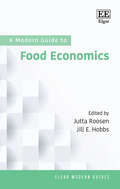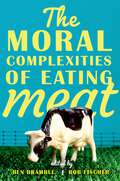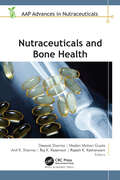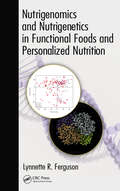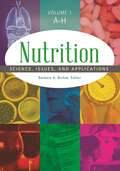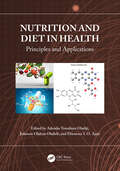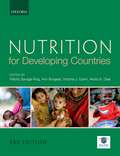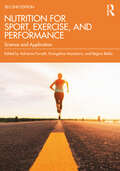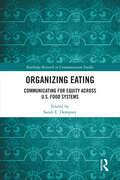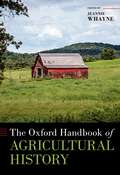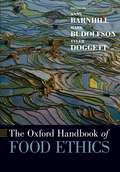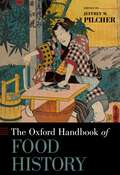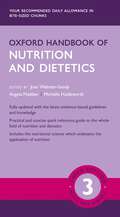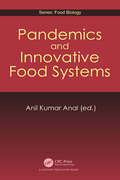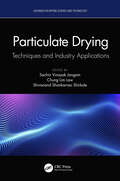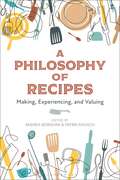- Table View
- List View
A Modern Guide to Food Economics (Elgar Modern Guides)
This Modern Guide provides detailed theoretical and empirical insights into key areas of research in food economics. It takes a forward-looking perspective on how different actors in the food system shape the sustainability of food production, distribution, and consumption, as well as on major challenges to efficient and inclusive food systems.Analysing the main characteristics of modern food markets, chapters introduce readers to the economics of food systems, product differentiation, the mediating role of food retailers, and the increasing significance and complexity of international trade in food. Encapsulating new methods in the study of food economics and policy, this Modern Guide explores changes in food value chains and consumption. It further pushes the boundaries of food economics to include economic perspectives on the role of social media and technology such as genomics in shaping food systems.Offering key insights into the state-of-the-art debates in the field, this Modern Guide will be critical reading for graduate students and researchers of food economics. It will also be a timely book for practitioners in the field wishing to take a fresh look at issues shaping food systems.
The Moral Complexities of Eating Meat
A new collection offering provocative and often counterintuitive conclusions on the ethics of meat eating In a world of industralized farming and feed lots, is eating meat ever a morally responsible choice? Is eating organic or free range sufficient to change the moral equation? Is there a moral cost in not eating meat? As billions of animals continue to be raised and killed by human beings for human consumption, affecting the significance and urgency in answering these questions grow. This volume collects twelve new essays by leading moral philosophers who address the difficult questions surrounding meat eating by examining various implications and consequences of our food choices. Some argue for the moral permissibility of eating meat by suggesting views such as farm animals would not exist and flourish otherwise, and the painless death that awaits is no loss to them. Others consider more specific examples like whether buying french fries at McDonalds is just as problematic as ordering a Big Mac due to the action's indirect support of a major purveyor of meat. The Moral Complexities of Eating Meat is a stimulating contribution to the ongoing debate on meat consumption and actively challenges readers to reevlaute their stand on food and animal ethics.
Nutraceuticals and Bone Health (AAP Advances in Nutraceuticals)
Here is an informative volume on the importance of nutraceuticals and herbal remedies for bone health. It explains the probable mechanisms of nutraceuticals for the prevention, treatment, and management of bone-related diseases as well as their curable effects on bone injuries. The volume covers the progression and development of bones, which is a multifaceted process that requires an endless and ample supply of nutrients, such as calcium, phosphorus, potassium, protein, vitamin D, magnesium, and fluoride. The book delves into the beneficial effects of nutraceuticals on overall bone health and for the treatment of bone disorders such as osteoporosis, bone fractures, scoliosis and related complications, rheumatoid arthritis, Paget’s disease, bursitis, gout, and carpal tunnel syndrome. It also addresses the use of nutraceuticals for inflammatory deformities and rickets.
Nutrigenomics and Nutrigenetics in Functional Foods and Personalized Nutrition
While functional foods have become a reasonably well-established concept, personalized nutrition is still treated with skepticism by many. The recognition that people would have different nutrient requirements, or perceive foods in different ways, raises several concerns-some real, some not so real. Nutrigenomics and Nutrigenetics in Functional Foo
Nutrition [2 volumes]: Science, Issues, and Applications [2 volumes]
This thorough one-stop resource draws on solid science and the latest research to play a dual educational role—providing background for students while answering general readers' questions about a wide range of nutrition-related topics.Nutrition is a popular but often misunderstood topic, one about which there is a great deal of interest as evidenced by the plethora of available advice. Because nutrition is a key factor in health, it is important that the public have a source of information they can trust. This is that source: a comprehensive overview that will help readers make sense of conflicting information they find in the media regarding what is healthy and what is not. Organized alphabetically, the two-volume work covers the most important topics in human nutrition including nutrients, nutrition-related health concerns, aging and nutrition, eating disorders, and the value of dietary supplements. The digestive system and its organs are discussed, with particular attention to health issues such as irritable bowel syndrome and the role of helpful bacteria. The physiology of hunger and the psychology of appetite and eating behaviors are explained. The work also delves into data on foods that have been featured in recent research, such as garlic, ginger, and turmeric, and it offers consumers a clearer understanding of nutrition-related practices such as organic farming, genetically modified foods, and the use of food additives.
Nutrition and Diet in Health: Principles and Applications
Nutrition and diet play a crucial role in sustaining good health throughout human lives. Food provides us with essential nutrients involved in many physiological activities and biological processes in the body including growth and development, metabolism, immune function, and overall well-being. Nutrition and Diet in Health: Principles and Applications reviews and discusses the issues related to the roles of nutrition and diet in human health and diseases.The book contains two sections – one section features principles, the other, covers applications. Part I provides information on sustainable use of nutrition and diets in health and diseases; advanced biotechnological approaches to improve nutritional content of food; trace elements in nutrition; drug and nutrient interactions; functional foods and nutraceuticals in health maintenance; and biomarkers of functional foods and nutraceuticals in health maintenance. Part II discusses the significance of nutrition in selected human diseases, including cardiovascular diseases, cancer, infection, neurodegenerative diseases, and metabolic co-morbidities. It also discusses optimal nutrition for wellness, fitness, pregnancy, mental health, aging, and longevity.Features Molecular and cellular-based research findings on the principles and applications of nutrition and diet in health Roles of nutritional agents in the pathogenesis of human diseases Underlying mechanisms that govern activities and strategies to prevent pathological conditions using nutritional agents Nutrition and Diet in Health: Principles and Applications is suitable for academia and scientists, enhances knowledge of students in healthcare and areas of biological sciences.
Nutrition for Developing Countries
Nutrition is an essential component of the work of all health and community workers, including those involved in humanitarian assistance, and yet it is often neglected in their basic training. Drawn from the experiences of an international editor team with extensive field experience, Nutrition for Developing Countries brings together the essential basics of nutrition in an easily accessible form which is accurate, up-to-date and practical, and suitable for a wide range of readers at different levels. The book covers the whole life cycle, including pregnancy, breastfeeding, complementary feeding, older children, adolescents, adults and the elderly, with an emphasis on the most vulnerable women and children. The fully revised and updated edition addresses both the long standing problems of undernutrition and malnutrition, and the growing epidemic of overnutrition and obesity, which are responsible for the rapid increase in non-communicable diseases of later life. Generously illustrated, Nutrition for Developing Countries explains in clear simple language, and practical detail, how nutrition workers can help families with nutrition problems, including many ideas for exercises for training nutrition workers.
Nutrition for Sport, Exercise, and Performance: Science and Application
Nutrition for Sport, Exercise, and Performance offers a clear, practical, and accessible guide to building a comprehensive understanding of sport and exercise nutrition from leading experts in nutrition and exercise science. Nutrition before, during, and after training or a sporting event can improve the comfort, energy, and performance of athletes of all levels, from elite to recreational, as well as providing long-term health benefits. As such, nutrition is a key element of an athlete’s health and performance strategy, whether competing recreationally or at an elite level.Split into three parts, this new and revised edition of Nutrition for Sport, Exercise, and Performance provides an evidence-based introduction to nutrition for sport, exercise, and performance. Part I focusses on nutrition and sport science by explaining key principles underpinning sports nutrition science, including energy systems, exercise physiology and metabolism, and the digestion and absorption of macronutrients and micronutrients essential for performance and discusses factors influencing dietary intake, energy availability, and the process of dietary assessment. Part II is focussed on nutrition for exercise, pre- and post-training, hydration, supplements, and body composition measurement and modification. The final part (Part III) focusses on applied sports nutrition for a range of sports and athletes. This second edition delivers new insights into working with female athletes, occupational athletes, and athletes in contemporary sports including sport climbing, surfing, skateboarding, and breaking.Featuring contributions from a range of sport and exercise nutrition professionals with practical sports nutrition strategies and the latest evidence and practice guidelines, this is a core reference for undergraduate students, sports professionals, and aspiring athletes alike.
Orange (Cross Section) (Large Print)
This is a labelled image of an orange shown in horizontal cross section (cut through from side to side). There is a locator dot shown, which will be at the top left of the page when the image is the correct way up. The orange is shown in centre of the page. The roughly triangular shapes of the segments in cross section are arranged around the centre of the fruit. In each segment, near the centre of the image, there is a pip (seed) shown. This will not always be the case as many varieties have been bred to be seedless. The skin or peel of the orange comprises soft pith covered by a thin layer, commonly known as zest; it contains fruity, aromatic oils and is often used by chefs to add citrus notes to dishes. The orange can vary from six to twelve centimetres in diameter.
Orange (Cross Section) (UEB Contracted)
This is a labelled image of an orange shown in horizontal cross section (cut through from side to side). There is a locator dot shown, which will be at the top left of the page when the image is the correct way up. The orange is shown in centre of the page. The roughly triangular shapes of the segments in cross section are arranged around the centre of the fruit. In each segment, near the centre of the image, there is a pip (seed) shown. This will not always be the case as many varieties have been bred to be seedless. The skin or peel of the orange comprises soft pith covered by a thin layer, commonly known as zest; it contains fruity, aromatic oils and is often used by chefs to add citrus notes to dishes. The orange can vary from six to twelve centimetres in diameter.
Orange (Cross Section) (UEB Uncontracted)
This is a labelled image of an orange shown in horizontal cross section (cut through from side to side). There is a locator dot shown, which will be at the top left of the page when the image is the correct way up. The orange is shown in centre of the page. The roughly triangular shapes of the segments in cross section are arranged around the centre of the fruit. In each segment, near the centre of the image, there is a pip (seed) shown. This will not always be the case as many varieties have been bred to be seedless. The skin or peel of the orange comprises soft pith covered by a thin layer, commonly known as zest; it contains fruity, aromatic oils and is often used by chefs to add citrus notes to dishes. The orange can vary from six to twelve centimetres in diameter.
Organizing Eating: Communicating for Equity Across U.S. Food Systems (Routledge Research in Communication Studies)
This book develops "organizing eating" as an organizational-communication centered framework for understanding how communication and power combine to actively shape eating and working in the U.S. food system. Drawing together established scholars, the book sheds light on how the interconnected aspects of power are communicative in nature, shaping and constraining the possibilities for organizing across the food system. The chapters provide grounded insight into the role of racism, corporate and state power, food cooperatives, urban farm systems, food policy, and labor practices, drawing attention to the pathways needed to pursue more equitable food systems. Providing readers with a set of useful critical conceptual tools and an understanding of communication frameworks, chapters identify common principles for critical organizing within the food movement and addresses the relevance of the COVID-19 pandemic and the national uprising against anti-Black violence for understanding the urgent possibilities of food justice. This cohesive collection of cutting-edge scholarship will be of interest to organizational communication scholars, critical/cultural communication scholars, environmental communication scholars, and health communication scholars; and the interdisciplinary fields of environmental studies, agriculture and food studies, and organization and labor studies.
The Oxford Handbook of Agricultural History (Oxford Handbooks)
Agricultural history has enjoyed a rebirth in recent years, in part because the agricultural enterprise promotes economic and cultural connections in an era that has become ever more globally focused, but also because of agriculture's potential to lead to conflicts over precious resources. History is replete with stories of armies standing or falling as a result of their supply of agriculturally produced commodities. Civilizations have likewise succumbed because of famine or crop-related pestilence, highlighting the critical nature of agriculture to both regional and global society. The importance and fragility of agricultural systems will come into much greater focus because of climate change in the twenty-first century, something farmers the world over have begun to reckon with. As its implications are manifested in droughts and floods that hamper crop production, urban people will become ever more conscious of their own reliance upon agriculture. The contemporary critical evaluation of agriculture reflects a transition from a framework that celebrated the positive aspects of the evolution of agriculture to one that also explores its negative implications, such as the emergence of intensive and extractive agriculture that has worked to the detriment of indigenous peoples and disrupted traditional political economies. The Oxford Handbook of Agricultural History reflects this rebirth and examines the wide-reaching implications of agricultural issues, bringing together the many historiographical traditions within geographic regions across the world that intersect either directly or indirectly in terms of agricultural history. Contributors to this volume include historians from around the world and specialists in European, American, African, Middle East, Russian, and Asian history. Essays touch on the green revolution, the development of the Atlantic slave plantation, the agricultural impact of the American Civil War, the rise of scientific and corporate agriculture, and modern exploitation of agricultural labor. The Oxford Handbook of Agricultural History is an essential volume for those interested in the myriad ways that agricultural systems affect our world.
The Oxford Handbook of Food Ethics (Oxford Handbooks)
Academic food ethics incorporates work from philosophy but also anthropology, economics, the environmental sciences and other natural sciences, geography, law, and sociology. Scholars from these fields have been producing work for decades on the food system, and on ethical, social, and policy issues connected to the food system. Yet in the last several years, there has been a notable increase in philosophical work on these issues-work that draws on multiple literatures within practical ethics, normative ethics and political philosophy. This handbook provides a sample of that philosophical work across multiple areas of food ethics: conventional agriculture and alternatives to it; animals; consumption; food justice; food politics; food workers; and, food and identity.
The Oxford Handbook of Food History (Oxford Handbooks)
Food matters, not only as a subject of study in its own right, but also as a medium for conveying critical messages about capitalism, the environment, and social inequality to diverse audiences. Recent scholarship on the subject draws from both a pathbreaking body of secondary literature and an inexhaustible wealth of primary sources--from ancient Chinese philosophical tracts to McDonald's menus--contributing new perspectives to the historical study of food, culture, and society, and challenging the limits of history itself. The Oxford Handbook of Food History places existing works in historiographical context, crossing disciplinary, chronological, and geographic boundaries while also suggesting new routes for future research. The twenty-seven essays in this book are organized into five sections: historiography, disciplinary approaches, production, circulation, and consumption of food. The first two sections examine the foundations of food history, not only in relation to key developments in the discipline of history itself--such as the French Annales school and the cultural turn--but also in anthropology, sociology, geography, pedagogy, and the emerging Critical Nutrition Studies. The following three sections sketch various trajectories of food as it travels from farm to table, factory to eatery, nature to society. Each section balances material, cultural, and intellectual concerns, whether juxtaposing questions of agriculture and the environment with the notion of cookbooks as historical documents; early human migrations with modern culinary tourism; or religious customs with social activism. In its vast, interdisciplinary scope, this handbook brings students and scholars an authoritative guide to a field with fresh insights into one of the most fundamental human concerns.
Oxford Handbook of Nutrition and Dietetics (Oxford Medical Handbooks)
The importance of nutrition in the prevention and treatment of disease and the maintenance of good health is being increasingly recognised. Nutrition is an area that all health professionals need to be aware of and yet one in which few are specifically trained. However it is now becoming a valued topic in many curricula. The Oxford Handbook of Nutrition and Dietetics makes this information more accessible to dieticians, doctors, nurses, nutritionists, and other healthcare professionals by providing a practical, easily accessible, concise and up-to-date evidence-based guide in a user-friendly portable handbook. It covers the entire life cycle from preconception to old age. As the general public is increasingly aware of the food they eat and the role nutrition plays in health and disease, health professionalsmust have the kind of knowledge in this book at their fingertips.
Pandemics and Innovative Food Systems (Food Biology Series)
The debate on health, nutrition and food security could not have arisen at a more opportune time. The recent pandemic has given rise to increased food and nutrition insecurity for individuals, families, and communities. The crisis threatened the food security and nutrition of millions of people, many of whom were already suffering. We face possible disruptions to the functioning of food systems, with severe consequences for health and nutrition. Pandemics create a greater burden for poorer countries and countries since they are already pressure of inadequate food supplies. With concerted action, we can not only avoid some of the worst impacts but do so in a way that supports a transition to more sustainable food systems that are in better balance with nature and that support healthy diets – and thus better health prospects for all. This book aims to highlight the impact of pandemics in food systems and nutrition security. It draws on the experience from the past and present pandemics to better prepare the world for future crises.
Particulate Drying: Techniques and Industry Applications (Advances in Drying Science and Technology)
In the process industry, understanding the unit operation of particulate drying is imperative to yield products with desired properties and characteristics and to ensure process safety, optimal energy efficiency and drying performance, as well as low environmental impact. There are many techniques and tools available, which can cause confusion. Particulate Drying: Techniques and Industry Applications provides an overview of various particulate drying techniques, their advantages and limitations, industrial applications, and simple design methods. This book: • Covers advances in particulate drying and their importance in the process industry • Highlights recent developments in conventional drying techniques and new drying technologies • Helps readers gain insight into selecting the appropriate drying techniques for a particular product • Summarizes various applications from a wide range of industries, including chemical, food, pharmaceutical, biotech, polymer, mineral, and agro-industries • Projects future research trends and demands in particulate drying This book serves as a reference for process and plant engineers as well as researchers in the fields of particulate processing, mineral processing, food processing, chemical engineering, and mechanical engineering, especially those involved in the selection of drying equipment for particulate solids and R&D of drying of particulate materials.
Pear (Large Print)
This is an image of a sweet and juicy pear, with its stalk and two leaves. It is shown slightly larger than life-size. There is a locator dot shown, which will be at the top left of the page when the image is the correct way up.The two leaves are in the top centre of the page, attached to the stalk below. Down the page from the stalk is the fruit. It is small at the top and fat at the bottom. At the very bottom of the pear is a little shrivelled bit: the remains of the flower it has grown from.
Pear (UEB Contracted)
This is an image of a sweet and juicy pear, with its stalk and two leaves. It is shown slightly larger than life-size. There is a locator dot shown, which will be at the top left of the page when the image is the correct way up.The two leaves are in the top centre of the page, attached to the stalk below. Down the page from the stalk is the fruit. It is small at the top and fat at the bottom. At the very bottom of the pear is a little shrivelled bit: the remains of the flower it has grown from.
Pear (UEB Uncontracted)
This is an image of a sweet and juicy pear, with its stalk and two leaves. It is shown slightly larger than life-size. There is a locator dot shown, which will be at the top left of the page when the image is the correct way up.The two leaves are in the top centre of the page, attached to the stalk below. Down the page from the stalk is the fruit. It is small at the top and fat at the bottom. At the very bottom of the pear is a little shrivelled bit: the remains of the flower it has grown from.
A Philosophy of Recipes: Making, Experiencing, and Valuing
This volume addresses the nature and identity of recipes from a cross-disciplinary perspective. Contributors study the values and norms guiding the naming, production, and consumption of recipes, scrutinizing their relationship to territory, makers, eaters, and places of production. Along the road, they uncover the multifaceted conceptual and value-laden questions that a study of recipes raises regarding cultural appropriation and the interplay between aesthetics and ethics in recipe making.With contributors specializing in philosophy, law, anthropology, sociology, history, and other disciplines, this volume will be of vital importance for those looking to understand the complex nature of food and the way recipes have shaped culinary cultures throughout history.
Pineapple (Large Print)
In the middle of the page is an image of a pineapple shown slightly smaller than life-size. There is a locator dot shown, which will be at the top left of the page when the image is the correct way up. The body of the fruit is in the bottom half of the page and the leaves are at the top.The green leaves of the pineapple splay out from the top of the fruit in the middle of the page. They have very sharp serrated edges. Down the page is the orange fruit of the pineapple. It is oval-shaped and covered in sharp pointy segments.
Pineapple (UEB Contracted)
In the middle of the page is an image of a pineapple shown slightly smaller than life-size. There is a locator dot shown, which will be at the top left of the page when the image is the correct way up. The body of the fruit is in the bottom half of the page and the leaves are at the top.The green leaves of the pineapple splay out from the top of the fruit in the middle of the page. They have very sharp serrated edges. Down the page is the orange fruit of the pineapple. It is oval-shaped and covered in sharp pointy segments.
Pineapple (UEB Uncontracted)
In the middle of the page is an image of a pineapple shown slightly smaller than life-size. There is a locator dot shown, which will be at the top left of the page when the image is the correct way up. The body of the fruit is in the bottom half of the page and the leaves are at the top.The green leaves of the pineapple splay out from the top of the fruit in the middle of the page. They have very sharp serrated edges. Down the page is the orange fruit of the pineapple. It is oval-shaped and covered in sharp pointy segments.
